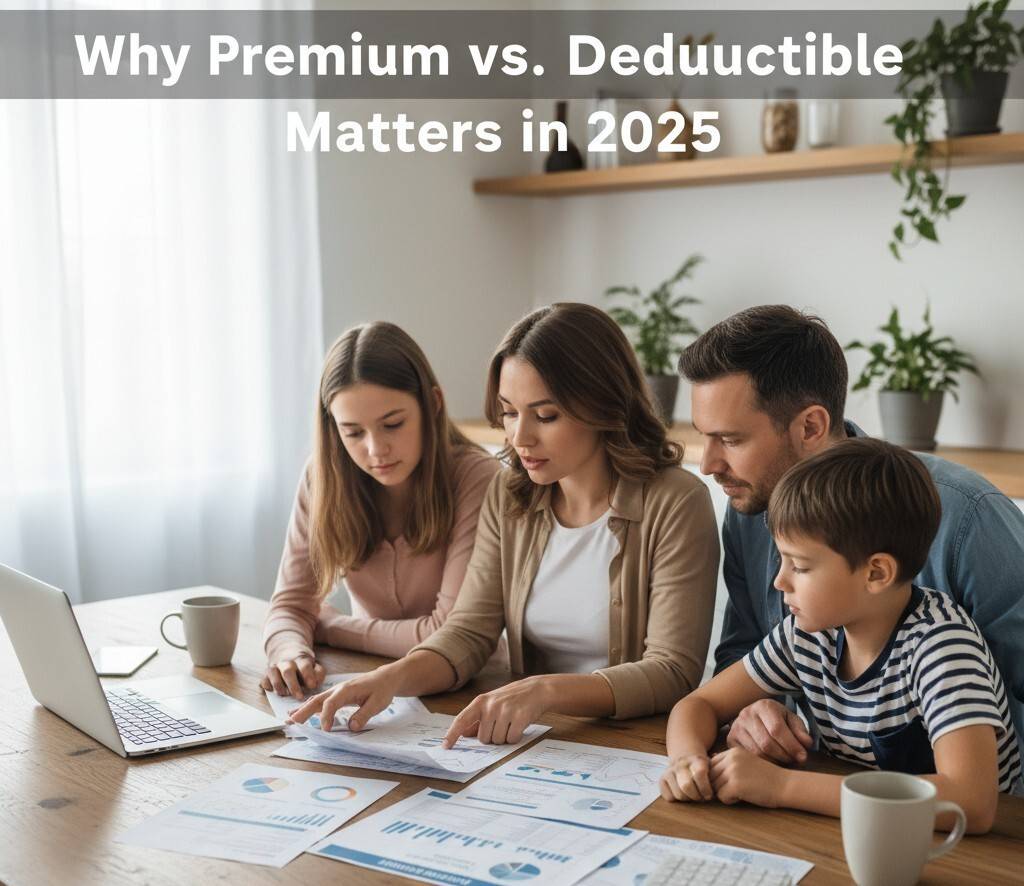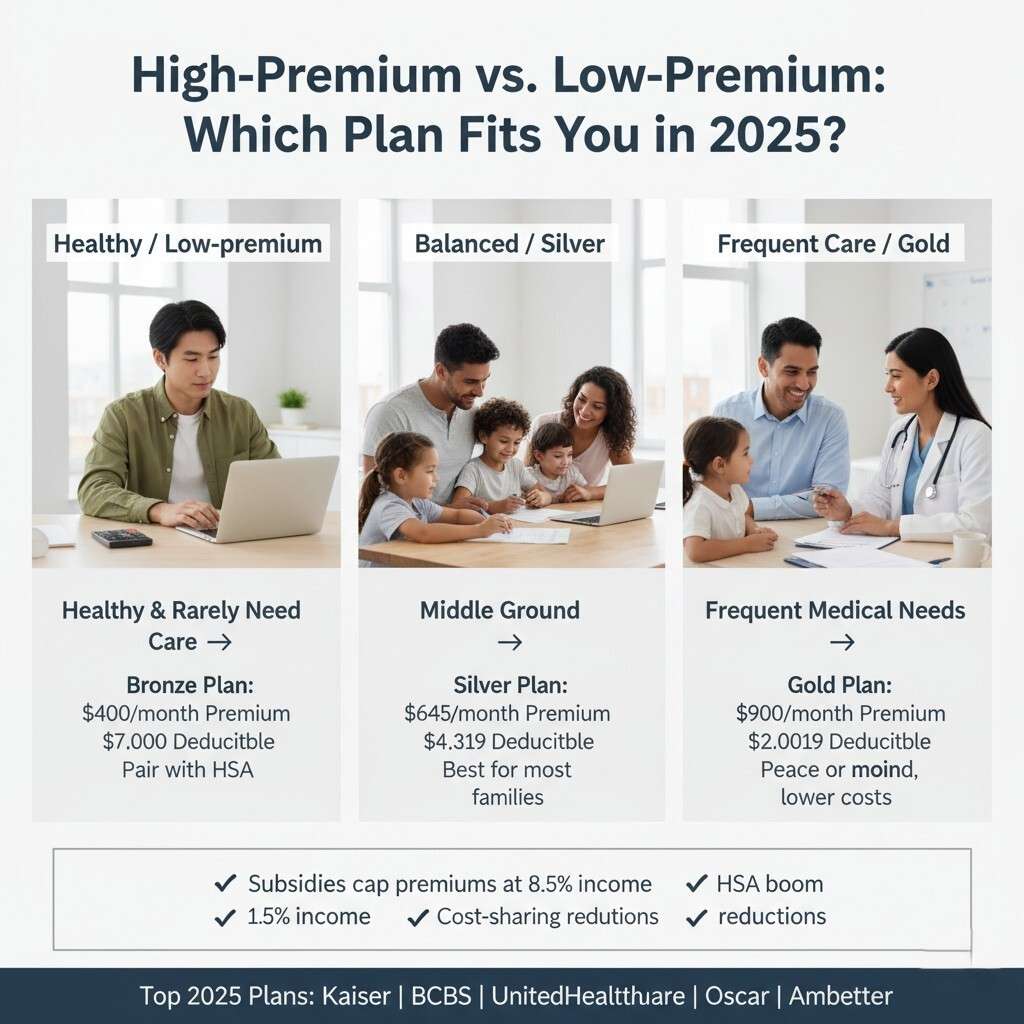
Yo, let’s talk health insurance. Ever tried picking a plan and felt like you’re decoding a secret spy message? Premiums, deductibles, copays—it’s a lot. Back in 2019, I was a newbie freelancer, stoked about a cheap plan I found, only to get hit with a $5,000 bill when I sprained my ankle and needed an ER visit. Total rookie mistake. If you’re wondering health insurance deductible vs. premium: what’s the difference?, I’m here to break it down in plain, no-BS language. This guide’s got you covered with real talk, personal lessons, and tips to pick a plan that won’t screw you over in 2025. Whether you’re solo, raising a family, or planning for retirement, you’ll know exactly how to balance premiums and deductibles to save cash and stress. Let’s dive in! I’ve been through the US healthcare grind—solo plans, family coverage, you name it. With family premiums averaging $25,572 a year in 2025 and healthcare costs jumping 6% annually, getting this right is huge. This deep dive into health insurance deductible vs. premium: what’s the difference? will clear up the confusion, help you budget smarter, and keep you protected. Grab a coffee (or chai), and let’s sort this out.
Why You Need to Get This Right in 2025
Health insurance isn’t just paperwork—it’s your backup when life gets messy. One hospital stay can cost $10,000-$30,000 without coverage, and trust me, you don’t want to pay that out of pocket. The Affordable Care Act (ACA) still rules the game in 2025, with sweet subsidies making plans more doable. For example, a family of four earning $80,000 can score $1,200+ in monthly premium cuts. But mess up the premium-deductible balance, and you’re either drowning in monthly payments or stuck with a massive bill when you need a doctor. My 2019 ER fiasco taught me that the hard way. I picked a plan with a low premium to save a few bucks, but the high deductible meant I was on the hook for thousands. Understanding health insurance deductible vs. premium: what’s the difference? would’ve saved me a ton of stress (and money). Let’s start with the basics to keep you from making the same mistake.

The Basics: Premiums vs. Deductibles, Explained Simply
Premiums: Your Monthly Ticket
Your premium is what you pay every month to keep your insurance active, whether you use it or not. Think of it like your Spotify subscription—you shell out $10 a month even if you skip playlists for a week. Premiums depend on your age, where you live, and whether you’re covering just yourself or a whole crew. Here’s the 2025 breakdown:
- Individual Premium: Around $645/month for a Silver plan (before subsidies).
- Family Premium: About $2,131/month for a family of four (Silver, unsubsidized).
- Subsidized Plans: If your income’s under $103,280 for a family of four (400% of the poverty line), premiums can drop to $500-$1,000/month.
Miss a payment? You get a 30-day grace period, but after 90 days, you’re out of luck and uninsured. Premiums are the steady, predictable part of health insurance deductible vs. premium: what’s the difference?—you know exactly what’s hitting your bank account each month.
Deductibles: Your Upfront Cost
The deductible is how much you pay out of your own pocket for medical stuff—like doctor visits, hospital stays, or prescriptions—before your insurance starts helping out. It’s like a gate you gotta pass through. If your deductible’s $5,000, you’re covering the first $5,000 of bills (except preventive care, which is free under ACA). For 2025:
- Individual Deductible: $4,319 on average for a Silver plan.
- Family Deductible: $8,638 for a family of four (Silver).
- High-Deductible Plans (HDHPs): Up to $8,300 for one person or $16,600 for a family, but they come with Health Savings Accounts (HSAs) for tax breaks.
Deductibles reset every January 1, so if you’ve got big medical stuff coming, plan smart. This is the core of health insurance deductible vs. premium: what’s the difference?—premiums keep your plan alive, deductibles hit when you actually use it. While comparing costs, it’s also important to explore the Top Family Health Insurance Plans in the USA to find coverage that fits your family’s needs. Check out the options, benefits, and premiums to make an informed choice.

How Premiums and Deductibles Work Together
Here’s the real talk: Premiums and deductibles are a trade-off, like choosing between paying rent or saving for a rainy day. Low premiums mean high deductibles—you save monthly but pay more when you need care. High premiums mean lower deductibles—your monthly budget takes a hit, but doctor visits cost less. Check out the ACA metal tiers:
- Bronze: $400/month premium, $7,000 deductible. Cheap to keep, expensive to use.
- Silver: $645/month premium, $4,319 deductible. Balanced, with extra savings for lower incomes.
- Gold: $900/month premium, $2,000 deductible. Higher monthly cost, but cheaper when you need care.
I fell for the low-premium trap in 2019, thinking I was winning at life with a $200/month plan. Then that ankle sprain hit, and the $5,000 deductible wiped out my savings. If I’d known health insurance deductible vs. premium: what’s the difference?, I’d have gone for a Silver plan and saved myself the headache.
Other Terms You Need to Know
To really get health insurance deductible vs. premium: what’s the difference?, let’s cover the rest of the lingo:
- Copay: A fixed fee, like $20 for a doctor visit or $15 for a prescription. Some plans (like Kaiser’s HMOs) let you pay copays without hitting the deductible.
- Coinsurance: The percentage you pay after meeting your deductible. If it’s 20%, a $10,000 bill means $2,000 out of your pocket (post-deductible).
- Out-of-Pocket Maximum: The most you’ll pay in a year for covered services. In 2025, ACA caps are $9,450 for one person, $18,900 for a family. Hit this, and insurance covers everything else.
- Network: The doctors and hospitals your plan works with. In-network saves you money; out-of-network can cost a fortune.
These all tie into health insurance deductible vs. premium: what’s the difference? because they shape what you actually pay. Premiums and deductibles are the big dogs, but copays and coinsurance fine-tune your costs.
High-Premium/Low-Deductible vs. Low-Premium/High-Deductible: Which One’s for You?

Choosing a plan is all about your health and budget. Let’s break down how to pick the right balance for health insurance deductible vs. premium: what’s the difference?.
If You’re Healthy and Rarely Need Care
Got no chronic issues and only hit the doctor for an annual checkup? A low-premium/high-deductible plan (like Bronze) keeps your monthly costs down—think $400/month, $4,800/year. If you need a quick urgent care visit, you might pay $300-$500 out of pocket. Pair it with an HSA to save tax-free for emergencies. I went this route in my 20s when I was healthy as a horse, and it worked great until that unexpected ER trip.
If You’ve Got Frequent Medical Needs
If you’re dealing with regular doctor visits—say, for kids, allergies, or chronic conditions like diabetes—a high-premium/low-deductible plan (like Gold) is safer. You’ll pay $900/month ($10,800/year), but a lower deductible ($2,000) means less out-of-pocket when you’re constantly at the doctor. I switched to a Silver plan after starting a family because my kids were always sick, and the predictable costs saved my sanity.
The Middle Ground
Silver plans are the Goldilocks option for most—$645/month, $4,319 deductible. They’re great if you want balance, especially with cost-sharing reductions for incomes under $64,550 (family of four). This is what I’m on now, and it’s been a lifesaver for my family’s frequent checkups.
Takeaway: Healthy and low-risk? Go low-premium/high-deductible with an HSA. Regular medical needs? High-premium/low-deductible for peace of mind. This is the heart of health insurance deductible vs. premium: what’s the difference?.
What’s Hot in 2025? Trends to Know
The healthcare scene’s always evolving, and 2025 brings some game-changers that affect health insurance deductible vs. premium: what’s the difference?:
- Juicy Subsidies: The Inflation Reduction Act keeps ACA subsidies strong through 2025, capping premiums at 8.5% of income. A $60,000-earning family could pay $425/month for Silver instead of $1,200.
- Telehealth Explosion: Plans like UnitedHealthcare offer unlimited virtual visits, often skipping the deductible—perfect for minor stuff like colds.
- HSA Boom: High-deductible plans with HSAs are in 20% of 2025 plans. Save up to $4,150 (individual) or $8,300 (family) tax-free.
- Cost-Sharing Wins: If your income’s under 250% of the poverty line ($64,550 for four), Silver plans slash deductibles to $1,000-$2,000.
These make low-premium plans tempting, but high deductibles can still bite. Keep this in mind for health insurance deductible vs. premium: what’s the difference?. For UK college students, finding the right health coverage can be challenging, especially when trying to balance studies and budget. Affordable Health Insurance for UK College Students offers plans that provide essential medical protection without breaking the bank. By exploring these options, students can ensure they’re covered for emergencies, routine check-ups, and unexpected health issues, giving peace of mind while focusing on their education. Check out the available plans, compare premiums, and choose the one that best fits your needs.
Top 2025 Plans to Consider

To show health insurance deductible vs. premium: what’s the difference? in action, here are five killer ACA plans for 2025, based on Forbes and MoneyGeek ratings. These are for a family of four on a Silver plan (unsubsidized unless noted):
- Kaiser Permanente HMO
- Premium: $1,800/month ($600-$800 subsidized).
- Deductible: $4,115 family.
- Why It Rocks: All-in-one care—doctors, hospitals, pharmacies. Free preventive visits, $20 copays. Perfect for busy families.
- Best For: High-premium/low-deductible folks in 8 states (CA, CO, etc.).
- Blue Cross Blue Shield PPO
- Premium: $2,200/month ($900-$1,200 subsidized).
- Deductible: $4,319 family.
- Why It Rocks: Massive network (1.7M+ providers), flexible PPOs, and perks like gym discounts.
- Best For: Families who travel or live in rural spots.
- UnitedHealthcare Choice
- Premium: $2,100/month ($700-$1,000 subsidized).
- Deductible: $3,500 family.
- Why It Rocks: Unlimited telehealth, $25 quarterly OTC credits, easy app.
- Best For: Tech-savvy families wanting lower deductibles.
- Oscar Health Silver
- Premium: $1,700/month ($500-$800 subsidized).
- Deductible: $4,760 family.
- Why It Rocks: Low denial rates (7%), concierge support for newbies.
- Best For: Budget-conscious younger families.
- Ambetter Balanced Care
- Premium: $1,600/month ($400-$700 subsidized).
- Deductible: $4,500 family.
- Why It Rocks: Cheapest premiums, mail-order meds for ease.
- Best For: Healthy families cool with higher deductibles.
Scope these out on Healthcare.gov during open enrollment (Nov 1, 2024-Jan 15, 2025). Each handles health insurance deductible vs. premium: what’s the difference? in its own way.
8 Tips to Pick the Perfect Plan
Here’s what I’ve learned from years of trial and error:
- Figure Out Your Health Needs: Chronic conditions or kids? Go high-premium/low-deductible. Rarely sick? Low-premium/high-deductible with an HSA.
- Check Subsidies: Use KFF’s calculator to see how much you can save. It’s a game-changer.
- Verify Networks: Make sure your go-to doctor’s in-network to avoid deductible shocks.
- Use HSAs Smartly: HDHPs let you save $8,300 tax-free for a family. I’m stashing $3,000 for future dental work.
- Lean on Telehealth: Virtual visits often dodge deductibles—great for quick fixes.
- Time Your Expenses: Deductibles reset in January, so plan big procedures early.
- Read the Details: Some plans (like Kaiser) let you pay copays pre-deductible—huge.
- Do the Math: Add up premiums + deductible + likely copays. eHealth’s cost tool is clutch.
These tips saved me $2,500 last year when I switched to a Silver plan with cost-sharing. Use them to nail health insurance deductible vs. premium: what’s the difference?.
5 Traps to Avoid
I’ve made these mistakes so you don’t have to:
- Chasing Cheap Premiums: A $400/month Bronze plan feels nice until a $7,000 deductible hits. My 2019 ER bill was a wake-up call.
- Ignoring Out-of-Pocket Max: A low max (like Ambetter’s $7,655) saves you in a crisis.
- Skipping Subsidies: 80% of ACA enrollees qualify—don’t miss out.
- Out-of-Network Blunders: Out-of-network bills can hit $10,000+. Always check providers.
- Missing Open Enrollment: Skip Nov-Jan, and you’re stuck or paying $500+/month for short-term plans.
Steer clear, and health insurance deductible vs. premium: what’s the difference? will be your strength.
Tailoring to Your Life Stage
- Families: Low copays for kid visits and pediatric dental/vision are key. Silver plans with cost-sharing rock.
- Pre-Medicare Seniors: High-premium/low-deductible for chronic issues. Cigna’s Healthy Aging riders are dope.
- Freelancers: Bronze plans with HSAs stretch your cash, and premiums are tax-deductible.
- Chronic Conditions: Gold or Platinum plans keep deductibles low. Kaiser’s diabetes programs are top-notch.
Choose with health insurance deductible vs. premium: what’s the difference? in mind for your situation.
The Mental Game: Staying Chill
Picking a plan can feel like a high-stakes poker game. I used to stress hard, worried I’d pick wrong and screw over my family’s budget. But once I matched my needs (lots of doctor visits) to a Silver plan, it was like exhaling after holding my breath. Check out Reddit’s r/HealthInsurance for real talk from others, and trust your numbers. You’ll feel unstoppable once you grasp health insurance deductible vs. premium: what’s the difference?. Looking to boost your income in 2025? Best Side Hustles 2025 for Beginners covers practical, easy-to-start ideas for anyone new to side income. From online gigs to small-scale businesses, these side hustles are designed to help beginners earn extra money, manage their time efficiently, and build financial stability. Explore the options, learn what works best for your skills, and start your side hustle journey today.
Your 2025 Action Plan
Here’s your no-nonsense guide to health insurance deductible vs. premium: what’s the difference? in 2025. My $5,000 mistake taught me to balance these costs by knowing my health needs and crunching the numbers. Start now: Jump on Healthcare.gov, check your subsidy eligibility, and pick a plan that lets you live without worrying about the next medical bill. Got a question? Hit the comments—I’m all ears. Here’s to a healthy, stress-free 2025!









